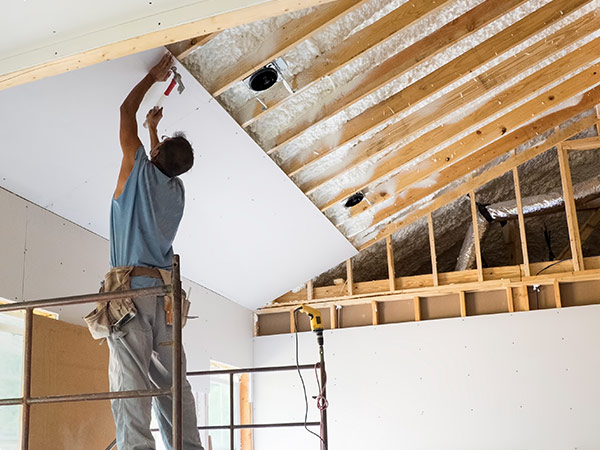

Know Before You Hang: Fire-Rated Drywall
Gone are the days of plaster and lath walls – they were costly, time-consuming, and hard to repair. Most modern buildings use panels of drywall to create smooth walls and ceilings that are easy on labor as well as cost-effective – and drywall comes with inherent fire resistance. But every construction project deserves consideration of your drywall’s fire rating.
What is the Building "Envelope"?
Keeping a building safe from elements such as air, moisture, heat, and light is the job of the building's “envelope.” The envelope must be designed based on the site conditions and the weather the building must withstand. For example, a lone house on a windy hill facing blizzards every winter will have different considerations than a home by the seaside that sees triple digits for months on end.
Some factors that make up the envelope include a building’s roof, foundation, and even the insulation between the walls. It also includes drywall – essentially the wall or ceiling “skin” that we often just see as a surface to be painted or hammered into. While a roof can keep the rain off, you also want a well-constructed roof that will drain heavy rain away without letting it creep into the home. You also want construction that won’t lock in that humidity inside your house, but instead “breathes” appropriately (without freezing you in the wintertime). This is where a building’s “layers” come into play.

Each layer you put on your structure works in tandem with other layers, from paint to shingles. Drywall contributes to the building envelope serving as part of the “air barrier” system in a building – one which may include a dozen components from the poured concrete to caulk to window glass and weatherstripping. If you have leaks there, you’ll also have trouble keeping the interior dry. The air barrier also can affect how fast a fire can spread in a building. You want to test a new construction's air barrier to ensure that fire can be slowed down (it can rarely be 100% contained) to give those who live or work there enough time to escape.
Air barrier testing can include using a dedicated service provider to come in and test a building or construction site for you with a series of specifically designed fans that generate reports. See the Air Barrier Association of America for more information on test standards.

Fire Safety and How to Choose Fire-Rated Drywall
You might see fire-rated drywall required by state or local building codes in spaces like:
- Utility rooms
- Walls between attached garages and the main structure
- Basements
- Furnace rooms
- Rooms with wood stoves
- Attached ceilings and walls near living areas
- Other locations depending on local laws
Here are Some Considerations for Fire-Rated Drywall
- Type X Drywall: This is fire-resistant drywall (sometimes called fire-code drywall) and it costs only slightly more than regular drywall but comes with important additional features.
First, this kind of drywall has a fire resistance time of at least one hour, giving those inside more time to head to the exits. Secondly, it comes with a bonus of sound dampening, meaning spaces with Type X drywall could be quieter than those with other types of drywall. Type X typically is made with glass fibers and a denser core which gives it additional strength during a fire.
If you wanted to use Type X drywall throughout a construction project, you could, but additional fire resistance in hallways, stairways, and other open areas will only be improved if you stop fire with resistant doors and other barriers, which aren’t typical in a family home. Type X typically has a longer longevity than Type C (below) and also costs less than Type C drywall. Type X is tested and standardized by the American Society for Testing and Materials' standards testing methods.
- Type C Drywall: With improved fire resistance from two to four hours, Type C drywall is considered more durable, smooth, and easy to paint. It's usually made with additional glass fibers and vermiculite for density and fire resistance. Some additional differences include:
- Increased strength when installed horizontally, making it great for use in ceilings.
- Thinner standard sizes that make it easier to lift and install.
- Lack of a defined standard can make code inspections difficult.
McCoy's Can Help You Pick the Right Drywall for Your Job
The experts at McCoy's can help you decide on the right type of drywall for your next construction project, based on your budget, the drywall's specific characteristics, and any other considerations you need to focus on. McCoy's carries several brands of drywall including Georgia Pacific, Panel Rey, and American Gypsum in many types and sizes.
